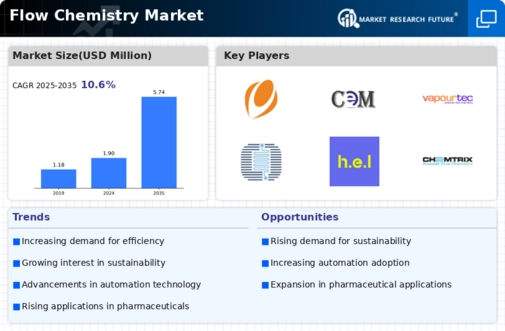Flow Chemistry Size
Flow Chemistry Market Growth Projections and Opportunities
The Flow Chemistry market is shaped by several key factors that impact its growth and development. One significant factor is the increasing adoption of flow chemistry technology across various industries. Flow chemistry offers numerous advantages over traditional batch processes, including enhanced reaction control, improved safety, and reduced environmental impact. As a result, industries such as pharmaceuticals, chemicals, and petrochemicals are increasingly incorporating flow chemistry into their manufacturing processes, driving market growth.
Furthermore, the demand for more efficient and sustainable production methods is driving the growth of the Flow Chemistry market. Flow chemistry enables continuous processing, which minimizes waste generation and energy consumption compared to batch processes. This aligns with the growing emphasis on sustainability and environmental responsibility, making flow chemistry an attractive option for companies seeking to reduce their carbon footprint and operating costs.
Technological advancements also play a crucial role in shaping the Flow Chemistry market. Continuous innovation in reactor design, automation, and process optimization has led to significant improvements in the efficiency, scalability, and versatility of flow chemistry systems. These advancements have expanded the scope of applications for flow chemistry beyond traditional synthetic chemistry, driving market growth and adoption across diverse industries.
Moreover, regulatory factors influence the adoption and development of flow chemistry technology. Regulatory agencies impose stringent safety and environmental regulations on chemical manufacturing processes, which drive companies to seek safer and more sustainable alternatives. Flow chemistry's ability to improve process safety, reduce hazardous waste, and enhance product quality positions it favorably in regulatory compliance, driving market growth.
Another key factor is the increasing investment in research and development (R&D) activities focused on flow chemistry. Academic institutions, research organizations, and industry players are investing heavily in R&D to develop novel catalysts, reaction methodologies, and flow chemistry platforms. These efforts aim to address current limitations and unlock new applications for flow chemistry, driving innovation and market expansion.
Market competition also influences the dynamics of the Flow Chemistry market. As the adoption of flow chemistry technology grows, an increasing number of companies are entering the market, driving competition and innovation. Established players and new entrants compete to develop proprietary technologies, expand their product portfolios, and capture market share, driving continuous advancements and improvements in flow chemistry systems.
Global economic conditions also impact the Flow Chemistry market. Factors such as GDP growth, industrial output, and investment trends influence demand for flow chemistry systems and services across different regions and industries. Economic downturns may temporarily slow market growth as companies delay investments in new technologies, while periods of economic expansion tend to stimulate demand for flow chemistry solutions.
Additionally, the availability and cost of raw materials play a significant role in shaping the Flow Chemistry market. The cost and availability of reagents, solvents, and catalysts impact the economics of flow chemistry processes and influence adoption rates. Fluctuations in raw material prices, supply chain disruptions, and geopolitical factors can affect production costs and market dynamics, driving manufacturers to seek alternative sources or optimize their processes.
Lastly, market factors such as mergers, acquisitions, and partnerships influence the competitive landscape and market dynamics of the Flow Chemistry market. Strategic collaborations between companies enable access to complementary technologies, expertise, and resources, driving innovation and market expansion. Mergers and acquisitions can lead to consolidation within the industry, with larger companies acquiring smaller players to strengthen their market position and expand their product offerings.










Leave a Comment